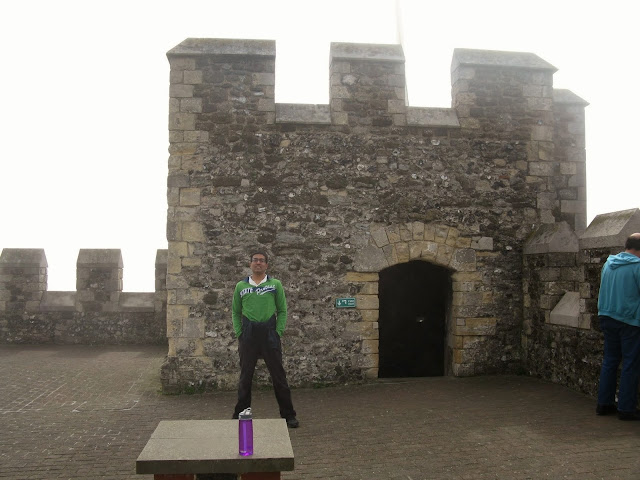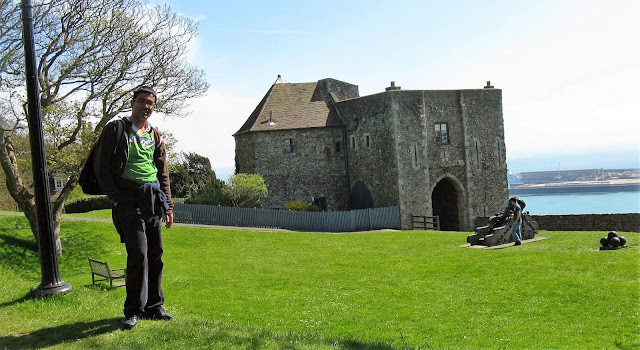DAY 9, MAY 6, 2013, Monday (22°C-11°C):
We caught the 8am train from London
Victoria and reached Dover Priory station after a 2 hour lovely
journey through green country side.
Put the ticket into the station machine
by mistake (the lever opens only when the ticket is in but if you
need the ticket, you have to go through the manual gate showing the
ticket to staff) ... then realised we needed the ticket to get our
discount at the Dover Castle— 2 for 1 offer is valid if we show the
rail tickets.
The station master was kind enough to
take out the ticket. We hailed a taxi (£6) from the station and
arrived in 5 minutes at the castle much ahead of our fellow
passengers who were walking the 2 mile distance.
DOVER CASTLE:
It was great to be the first on the
castle grounds—bought 2 tickets paying for just 1—£21.
It was a cool foggy morning... looked
great but has not photographed well...
Fog ruining the photo...this is the moat at the entrance. Can see the drawbridge.
Dover Castle is a medieval castle in
county of Kent. It was founded in the 12th century and has been
described as the "Key to England" due to its defensive
significance throughout history. It is the largest castle in
England. It has the shortest ferry ride—6km— from UK to
Europe—Calais in France.
Crossing the 800 year old drawbridge
and at the castle entrance... so nice having the place to ourselves.

The ticket counter girl told us to see
the secret war time tunnels first but we went to the main castle and
went up the main tower.
Cannons.
Henry II built the castle. In 1216, a
group of rebel barons invited Louis VIII of France to come and take
the English crown. He had some success breaching the walls but was
unable to take the castle.
During the siege, the English defenders
tunneled outwards and attacked the French, thus creating the only
counter tunnel in the world.
By the Tudor age, there was gunpowder
for defence. The castle was improved by Henry VIII, who made a
personal visit, and added the Moat.
The foggy weather added to the ambience
of being part of a royal past.
Drawbridge here...
Within this magnificent showpiece,
Henry could welcome and impress distinguished visitors to England–
particularly noble pilgrims travelling to the new shrine in
Canterbury Cathedral of St.Thomas Becket, slaughtered before the
altar by Henry’s household knights only a dozen or so years before
the Great Tower was begun.
This is the Great tower... climbed up the whole tower and took several videos of the awesome interior as the light inside was not enough for pics.
Great Tower, 83 feet high and 100 feet square, with walls up to 21 feet thick was built between 1180 and 1185.
Kitchen area.
The interior has been recently renovated... sat on the throne to see what that feels like...

The king's bed—when we returned on the way back, the curtains were drawn and a musician was playing a santoor like instrument to lull the king to sleep.
St Beckett painting near the bed...

Saint Thomas Becket was murdered at Canterbury. The church priest was against the taxes levied by the king Henry II. The king was annoyed by this revolt and exclaimed.. won't some one take care of this priest? His soldiers took this as an order to kill the priest and slayed him right inside the Canterbury cathedral when he was walking in for prayers. After his death, the priest was hailed as a saint by the people who flocked to pray to him at the cathedral. Several miracles started to happen and the king was aghast about the murder. He walked barefooted all the way to the cathedral and allowed himself to be flogged by all the 70 monks to atone for his sin.
Roaring wood fire was welcome.
A study nook.
No idea what this wheel is for.looks like a pulley system to pull up a trap door.
Chapel.
Palace comes alive—performer playing music in the king's bed chamber..we recorded it on video.
Once the king’s closest friend,
Becket had later become his bitter enemy objecting to his taxes: and though Henry probably
did not intend his murder, he did extravagant penance for a crime
which shocked all 12th-century Europe, walking barefoot to Canterbury
and allowing himself to be flogged there by all 70 cathedral monks.
Having done his penance, Henry capitalised on the situation and
re-established his prestige by building the Great Tower. Here the
distinguished visitors who began flocking to Becket’s tomb very
soon after his martyrdom could be in no doubt about the king’s
power, wealth and authority.
The museum is pretty good.
There were several local families with
kids as that Monday was a bank holiday. We chose it because there are
special shows of Castle comes alive on holidays.
Up on the terrace...
Down the battlement walks and circular
route.
WAR TUNNELS:
On our way to the war time tunnels.
No pics allowed inside...
has floorplans of the tunnels carved in
the limestone cliffs below the castle—it served as the naval HQ
during world war II. Only 40 persons allowed on one guided tour
which lasts 40 minutes...thankfully we joined the tour with hardly 5
minute wait. We walked through all the tunnels and heard the info
given by the navy guys and saw the actual footage as well as
enactments of the events of Operation Dynamo:
Troops were stranded at
Dunkirk as German forces closed in and had to be rescued.
Working inside Dover Castle's top
secret tunnels as war raged outside, Vice Admiral Bertram Ramsay
pulled off a miracle in just ten short days in 1940. With no
technology and with pitiful resources he masterminded the rescue of
338,000 troops.
Interesting ... we were reminded of our
Pearl Harbor visit in Hawaii... a lot of jingoism in the commentary
and the other side is painted as unmitigated villain.
These are pics from the net.
They can easily let in twice the number
at one go— lot of drama....
http://www.english-heritage.org.uk/daysout/properties/dover-castle/wartime-tunnels/operation-dynamo/
has a short video and pic inside the
tunnel.
After the tour we reached the outside
of the tunnels.
The info board on the operation..
has the panorama video of the chalk
tunnels we went through.
There are panorama pics of the sleeping
quarters at
There is a similar underground hospital
with an operating theatre— there was a queue entailing an hour wait
for that, so we decided we did not want to see it.
The
actual contents of the tunnels will take 5 minutes to glance and walk
through but they make it a big drama with a sound, light display
etc.. there is a panorama pic for these as well at the same website.
White cliffs:
Here's the famous white cliffs .
Another glimpse of the white cliffs and the sea. 350 feet down below.
The White Cliffs of Dover are cliffs
which form part of the English coastline facing the Strait of Dover
and France.
The cliff face, which reaches
up to 350 feet owes its striking façade to its composition of chalk
accentuated by streaks of black flint.
The cliffs have great symbolic value in
Britain because they face towards Continental Europe across the
narrowest part of the English Channel, where invasions have
historically threatened and against which the cliffs form a
symbolic guard.
Because crossing at Dover was the
primary route to the continent before the advent of air travel, the
white line of cliffs also formed the first or last sight of England
for travellers.
The cliffs are composed mainly of soft,
white chalk with a very fine-grained texture, composed of
calcium carbonate . Flint and quartz are also found in the chalk. In
a poll , the cliffs were named as the third greatest natural
wonder in Britain.
The cliff face continues to weather at
an average rate of 1 centimetre (0.39 in) per year, although
occasionally large pieces fall. On march 15th, 2013, just a
month before our visit a big bit of the cliff with tonnes of chalk
fell into the English channel:
Heavy artillery guns installed on the
roof.
Though this shuttle ride is included in
the price of our ticket we walked the grounds as the shuttle starts
only after 11.
Roman light house:
On the way to the Roman light house.
A small limestone rock from the
cliff.... the chalk keeps falling... quite dangerous.
At the foot of the 2000 year old
Roman light house.
It stands on the eastern heights of Dover within the fortification of Dover Castle. The lighthouse stands around 25m in height.
Alongside is St Mary in Castro Church, which used the lighthouse as a bell tower in the 13th century. this Saxon church was built on the Eastern Heights around AD1000.
Entrance to chapel— St Mary in Castro Church
It is immediately adjacent to the surviving eastern pharos, which was used as a source of spolia: Roman tiles can be still be seen in the church fabric, particularly in the window arches (usually of stone), and flint and tile from the pharos is used throughout the church's walls.
From 1555 to 1557 the church was walled up as it was felt unsafe due to lack of repairs,
Today Saint Mary in Castro is still a thriving church serving the Army and local people,
The vault and the altar recess were probably both added at the end of the twelfth century.
Local families have driven in—we got
a 2 for 1 discount for entry tickets for coming in by train.
tickets for all UK palaces/castles are
valid for 1 year—so nice for locals.
Had planned to take a speedboat ride on the channel but did not book in advance. Their return policy in case of bad weather was a coupon for use on another day which did not suit us tourists!
Rang up the company but there was only 1
seat available for the 2.30 ride. We decided to go back to London.
Report of our next day in London is here:
http://adventuretrav.blogspot.com/2017/08/uk-trip-report-day-10-london-st-pauls.html
Report of our next day in London is here:
http://adventuretrav.blogspot.com/2017/08/uk-trip-report-day-10-london-st-pauls.html







































































No comments:
Post a Comment